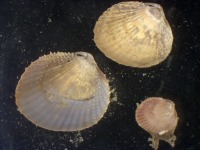
(Photo: Huntsman Marine Science Centre)
Tiny Cockle
Parvicardium pinnulatum
This small cockle reaches up to 12 millimetres in diameter. It is yellowish on the outside and white on the inside. Its surface has 24 to 26 radiating ribs. The anterior ribs (on the side opposite the siphons) bear broad scales. The posterior ribs (same side as the siphons) bear small spines, and the median ribs are smooth
Authority
Conrad, 1831
Classification Details
Phylum: Mollusca (molluscs); Class: Bivalvia (bivalve molluscs).
Habitat
Found throughout the North Atlantic and in the Mediterranean. It lives in the sublittoral zone, buried in gravel, mud, and sand seabeds, and can occur at depths up to 200 metres.
Diet
Filter feeder. Feeds on plankton and detritus in seawater. Water is drawn into the shell by the siphon. Particles are filtered out of the water using rows of filaments on the gills. Food is then bound in mucus and transported to the mouth.
Reproduction
Sexes are separate. Fertilization is external - males release sperm into the seawater and females release eggs. Eggs develop into a planktonic trochophore larval phase and then a planktonic veliger phase before settling on the seabed as pediveligers and developing into adults.
Fun Facts
Cockles are very important in marine food webs. Other animals, including whelks and birds, feed on them.
References
Ballerstedt S (2005) Parvicardium pinnulatum A cockle. In Tyler-Walters H. and Hiscock K. (eds) Marine Life Information Network: Biology and Sensitivity Key Information Reviews. Plymouth: Marine Biological Association of the United Kingdom. [cited 26-01-2020]. Available from: https://www.marlin.ac.uk/species/detail/1636 Accessed online 22 January 2020. Fish JD and Fish S (1996) A Student's guide to the Seashore. Cambridge: Cambridge University Press. Oliver PG, Holmes AM, Killeen IJ and Turner JA (2016). Parvicardium pinnulatum (Conrad, 1831) – Species Account. In Marine Bivalve Shells of the British Isles. Amgueddfa Cymru - National Museum Wales. Available from: https://naturalhistory.museumwales.ac.uk/BritishBivalves/browserecord.php?-recid=291 Accessed online 22 January 2020. Palomares MLD and Pauly D (2019) Sealife Base. Family: Cardiidae cockles – Non-fish Identification: Find Species. https://www.sealifebase.ca/summary/Parvicardium-pinnulatum.html Accessed online 22 January 2020.

